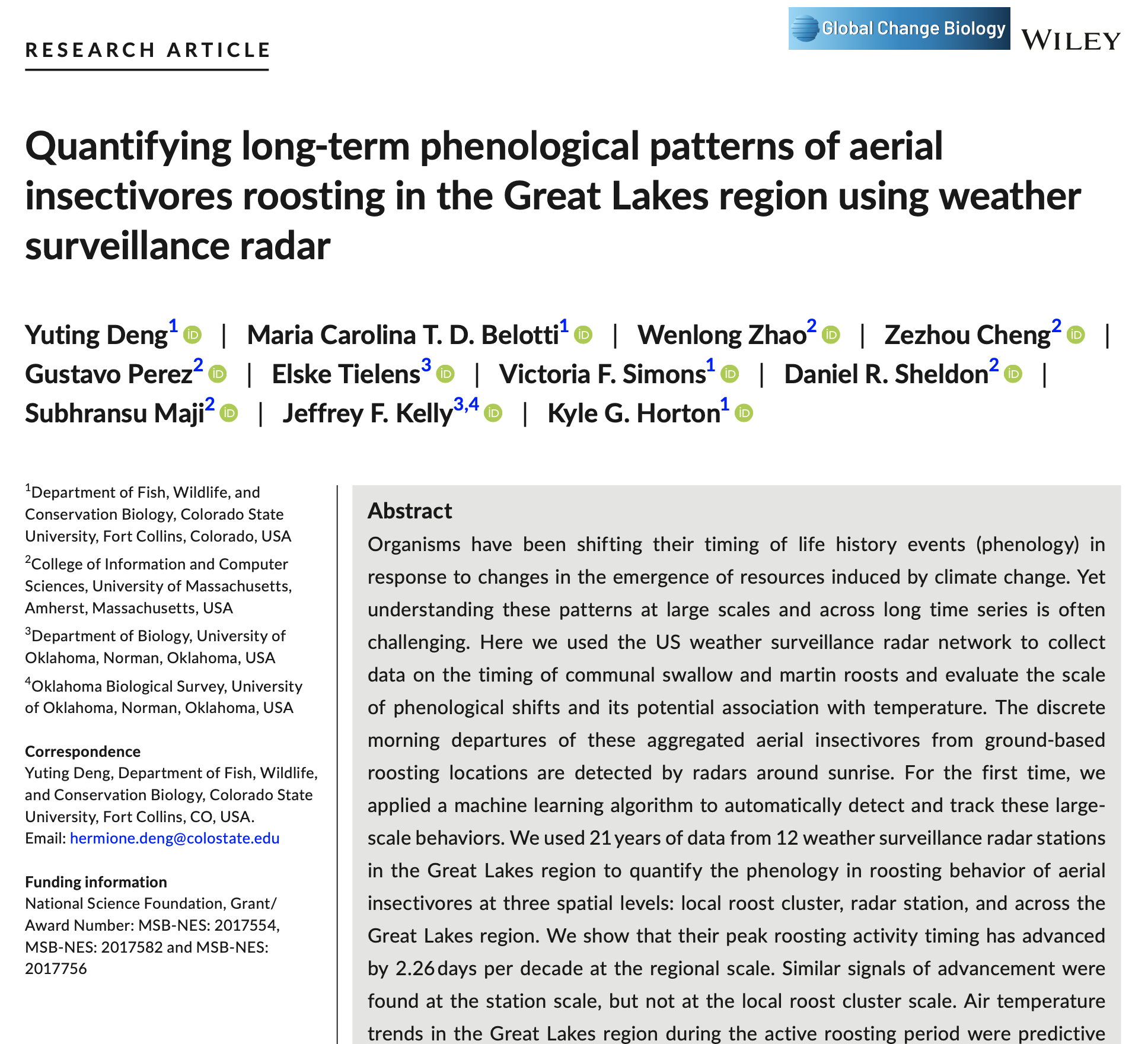insectivore response to environmental change
Aerial insectivores have shown dramatic population declines, but information beyond breeding season declines is largely absent, restricting our ability to discern mechanisms of decline and phenological change — mechanisms that broadly apply to hundreds of species of insects, birds, and bats. We focus our investigation on the roosting behavior of three aerial insectivore species as bellwethers for environmental change and ecosystem health: Purple Martin, Tree Swallow, and Mexican free-tailed Bat. These three species, diverse in behavior and morphology, are unified by their reliance on airspace to forage for insect prey.
Team Members
Publications
“The communal roosting behavior of swallows and martins is an important part of their survival strategy,” said Maria Tiburcio Dias Belotti, a Ph.D. student in fish, wildlife and conservation biology and an author of both papers. “Understanding what is driving changes of this behavior throughout the years is likely to help us figure out why these species have been facing declines and what we can do to stabilize their populations.”
“Our results showed that this shift could lead to a shortened pre-migratory roosting season, which could mean that birds have less time to fuel up for the upcoming migration,” said Yuting Deng, a Ph.D. student in fish, wildlife and conservation biology and an author of both papers. “That may cascade to a lower chance of survival during fall migration or worse body condition when they reach the wintering ground.”
Roosts are large communal aggregations of organisms. For swallows, martins, and free-tailed bats, the function and timing are largely non-overlapping in one or both of these traits.
For martins, roosts form from late summer to early fall, after their summer breeding season. For tree swallows, roosts form from late fall to early winter (see figure above). Each night, droves of birds concentrate into discrete parcels of terrestrial habitat; at times, tens of thousands of individuals gather in single trees or structures. The rapid morning exodus from these sites are diagnostically detected by radar remote sensors, when within the hour before local sunrise, martins and swallows quickly rise to high altitudes upon departing for daily foraging bouts. It is unclear why these roosts form, but these aggregations certainly provide a fitness benefit in protection and information sharing. While martin roosts disperse from the North American landscape in early fall, taking residence in South America for the winter, Tree Swallows, a shorter distance migrant, persist and roost throughout the fall and into the winter at southern latitudes within the United States.
Roosts of free-tailed bats serve an entirely different purpose. In early to mid-spring, female free-tailed bats return to the southern United States from Central and South America to form maternity colonies (i.e., roosts). Colonies form in caverns and human structures (e.g., bridge underpasses, tunnels), and like martins and swallows, it is the exodus, in this case, the nightly exodus that is captured by radars. By late summer, young begin to emerge, with colonies frequently swelling to many hundreds of thousands of individuals (sometimes millions).
These three species provide variation in key traits such as migration distance and roost seasonality, while being united in the vast abundance of individuals congregating and utilizing the aerosphere.
We hope to understand how global environmental change has impacted seasonal timing and population abundance of aerial insectivores over the past 25 years. Understanding mechanisms driving these changes would have broad implications for aerial organisms and also serve as an indicator of terrestrial and aquatic ecosystem health. However, the datasets needed to understand these mechanisms are currently lacking and urgently needed. While macroscale remote-sensing platforms for animals are rare, the United States weather surveillance radar network has emerged as a comprehensive source of information about flying animals, with large-scale and long-term (>two decades) coverage. This collaboration between Colorado State University, University of Oklahoma, and University of Massachusetts will employ an interdisciplinary approach integrating radar remote sensing, the National Ecological Observatory Network (NEON), and computer science to fill this vital gap to test questions about population change, phenology, and trophic interactions in response to anthropogenic drivers of macroscale environmental change.


















